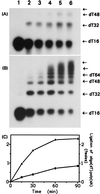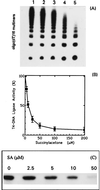Deficient DNA-ligase activity in the metabolic disease tyrosinemia type I
- PMID: 9770534
- PMCID: PMC22879
- DOI: 10.1073/pnas.95.21.12614
Deficient DNA-ligase activity in the metabolic disease tyrosinemia type I
Abstract
Hereditary tyrosinemia type I (HT1) is an autosomal recessive inborn error of metabolism caused by the deficiency of fumarylacetoacetate hydrolase, the last enzyme in the tyrosine catabolism pathway. This defect results in accumulation of succinylacetone (SA) that reacts with amino acids and proteins to form stable adducts via Schiff base formation, lysine being the most reactive amino acid. HT1 patients surviving beyond infancy are at considerable risk for the development of hepatocellular carcinoma, and a high level of chromosomal breakage is observed in HT1 cells, suggesting a defect in the processing of DNA. In this paper we show that the overall DNA-ligase activity is low in HT1 cells (about 20% of the normal value) and that Okazaki fragments are rejoined at a reduced rate compared with normal fibroblasts. No mutation was found by sequencing the ligase I cDNA from HT1 cells, and the level of expression of the ligase I mRNA was similar in normal and HT1 fibroblasts, suggesting the presence of a ligase inhibitor. SA was shown to inhibit in vitro the overall DNA-ligase activity present in normal cell extracts. The activity of purified T4 DNA-ligase, whose active site is also a lysine residue, was inhibited by SA in a dose-dependent manner. These results suggest that accumulation of SA reduces the overall ligase activity in HT1 cells and indicate that metabolism errors may play a role in regulating enzymatic activities involved in DNA replication and repair.
Figures





Similar articles
-
Hereditary tyrosinemia. Formation of succinylacetone-amino acid adducts.J Exp Med. 1985 Sep 1;162(3):1060-74. doi: 10.1084/jem.162.3.1060. J Exp Med. 1985. PMID: 3928801 Free PMC article.
-
Hereditary tyrosinemia and the heme biosynthetic pathway. Profound inhibition of delta-aminolevulinic acid dehydratase activity by succinylacetone.J Clin Invest. 1983 Mar;71(3):625-34. doi: 10.1172/jci110809. J Clin Invest. 1983. PMID: 6826727 Free PMC article.
-
Fumarylacetoacetate inhibits the initial step of the base excision repair pathway: implication for the pathogenesis of tyrosinemia type I.J Inherit Metab Dis. 2013 Sep;36(5):773-8. doi: 10.1007/s10545-012-9556-0. Epub 2012 Nov 9. J Inherit Metab Dis. 2013. PMID: 23138988
-
Biochemical and Clinical Aspects of Hereditary Tyrosinemia Type 1.Adv Exp Med Biol. 2017;959:9-21. doi: 10.1007/978-3-319-55780-9_2. Adv Exp Med Biol. 2017. PMID: 28755181 Review.
-
Hereditary tyrosinemia type I--an overview.Scand J Clin Lab Invest Suppl. 1986;184:27-34. Scand J Clin Lab Invest Suppl. 1986. PMID: 3296130 Review.
Cited by
-
Point mutation instability (PIN) mutator phenotype as model for true back mutations seen in hereditary tyrosinemia type 1 - a hypothesis.J Inherit Metab Dis. 2012 May;35(3):407-11. doi: 10.1007/s10545-011-9401-x. Epub 2011 Oct 15. J Inherit Metab Dis. 2012. PMID: 22002443
-
Nitisinone in the treatment of hereditary tyrosinaemia type 1.Drugs. 2006;66(6):743-50. doi: 10.2165/00003495-200666060-00002. Drugs. 2006. PMID: 16706549
-
Clinical and ABCB11 profiles in Korean infants with progressive familial intrahepatic cholestasis.World J Gastroenterol. 2016 May 28;22(20):4901-7. doi: 10.3748/wjg.v22.i20.4901. World J Gastroenterol. 2016. PMID: 27239116 Free PMC article.
-
Partial complementation of a DNA ligase I deficiency by DNA ligase III and its impact on cell survival and telomere stability in mammalian cells.Cell Mol Life Sci. 2012 Sep;69(17):2933-49. doi: 10.1007/s00018-012-0975-8. Epub 2012 Mar 30. Cell Mol Life Sci. 2012. PMID: 22460582 Free PMC article.
-
Liver tumors in children with metabolic disorders.Transl Pediatr. 2015 Oct;4(4):290-303. doi: 10.3978/j.issn.2224-4336.2015.10.08. Transl Pediatr. 2015. PMID: 26835391 Free PMC article. Review.
References
Publication types
MeSH terms
Substances
LinkOut - more resources
Full Text Sources
Medical

